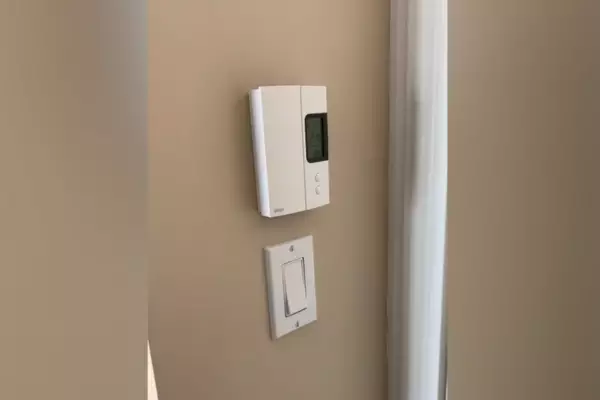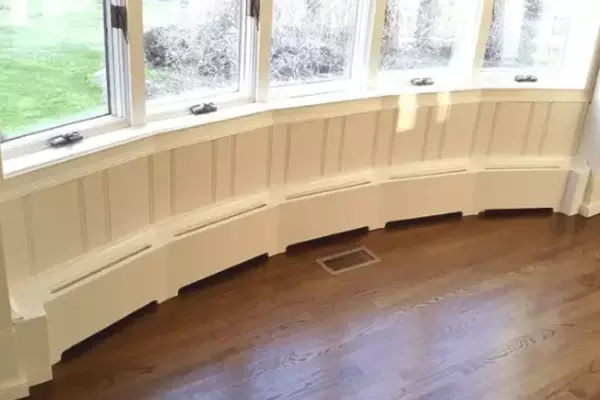Baseboard heaters are a common feature in many homes and commercial spaces, offering an efficient and cost-effective heating solution. Yet, they can pose challenges when it comes to arranging furniture, aesthetics, or planning an interior design.
Baseboard heaters require careful consideration due to safety and efficiency concerns. Proper positioning of furniture, appropriate use of materials, and effective covers can address these concerns while ensuring optimal heating performance.
The ways to work around baseboard heaters are many, and the choices depend largely on your individual needs, preferences, and the existing decor. With careful planning and design, baseboard heaters can integrate well into your space without sacrificing comfort or style.
Contents
Baseboard Heaters: A Brief
Definition and Use
Baseboard heaters are a long, narrow units installed along the baseboard of a room. These heaters are often used as a primary or supplementary source of heat in residential and commercial spaces. Their design allows them to work on the principle of convection or radiant heating.
In the case of convection heaters, the cool air in the room is drawn into the bottom of the heater, warmed up, and then expelled from the top, resulting in a continuous cycle of warm air circulation. Radiant baseboard heaters, on the other hand, heat the room by emitting infrared radiation, which directly warms objects and people in the room.

Pros and Cons
Baseboard heaters have a number of advantages that make them popular for heating spaces. They are relatively inexpensive to install, especially when compared to central heating systems. They offer the convenience of zone heating, allowing different rooms to be heated to different temperatures based on individual comfort levels.
However, they also have their share of disadvantages. They consume significant wall space, which can limit your options for furniture placement. They can also pose a fire risk if flammable materials are placed too close to them. Additionally, they might not be the most energy-efficient option if used as the primary source of heat in large spaces.
Tips for Safe Baseboard Heater Use
Common Safety Guidelines
Safety should always be a primary concern when dealing with baseboard heaters. Here are a few tips:
- Maintain Clearances: Ensure that you maintain a minimum clearance of 12 inches in front of the heater to prevent overheating and potential fire hazards.
- Check for Damage: Regularly inspect your heaters for any damage. Damaged heaters can pose a significant fire risk.
- Turn Off When Not in Use: Turn off your heaters when the room is unoccupied or when you’re away to prevent accidental fires.
Heat Resistant Materials
Heat-resistant materials can help prevent damage to furniture and other items that might be placed near the baseboard heaters. Metal and ceramic are both good choices as they can withstand high temperatures. If you plan on using wood, make sure it is properly treated or finished to improve its heat resistance.
Furniture Arrangement with Baseboard Heaters
Suitable Furniture Choices
When choosing furniture for a room with baseboard heaters, consider items that are high off the ground. Furniture with higher legs will allow heat to circulate better and prevent overheating. Materials such as metal, glass, and specially treated wood can withstand the heat better than untreated wood or plastic.
Ideal Furniture Layout
The layout of your furniture can significantly impact the efficiency of your baseboard heaters. Here are some tips:
- Ensure Adequate Spacing: There should be enough space between the heater and the furniture to allow heat to circulate freely.
- Avoid Taller Items: Try to avoid placing tall pieces of furniture near your heaters. They can block the heat and lead to uneven heating.

Constructing a Bookcase Over Baseboard Heater
Precautionary Measures
Before starting construction, it’s important to take some safety precautions. First, make sure the bookcase is made of heat-resistant materials or has a heat-reflective backing to protect it from the heat of the heater. Second, the design should allow for adequate ventilation to prevent overheating.
Designing the Bookcase
A well-designed bookcase can serve a dual purpose – providing storage and disguising your heater. When designing the bookcase, consider the overall aesthetic of your room. The bottom shelf should be high enough to avoid contact with the heater, and there should be enough space for air to circulate.
Building Process Steps
Here are some basic steps to follow when building your bookcase:
- Accurately measure the space where the bookcase will be placed.
- Choose heat-resistant materials or treated wood for construction.
- Cut the pieces of your bookcase according to the measurements.
- Assemble the bookcase using screws, nails, or other suitable fasteners.
- Install the bookcase, ensuring it’s stable and secure.
How to Build Around Baseboard Heaters
Tools and Materials Needed
To build around baseboard heaters, you’ll need some basic tools and materials. This includes heat-resistant boards, a saw, measuring tape, screws, a drill, and possibly paint or finish to match the rest of your decor.
Step-by-Step Process
- Measure: Start by measuring the area around the heater. This will help you determine the size of the boards you’ll need.
- Cut the Boards: Based on your measurements, cut the boards to the appropriate sizes.
- Assemble: Using screws and a drill, assemble the structure you’ve designed.
- Install: Once assembled, install the structure around the heater, ensuring it’s securely attached to the wall or floor.

Concealing Baseboard Heaters
Decorative Cover Options
To hide baseboard heaters, you have several options. Metal grilles, wooden slats, or even fabric covers made of fire-retardant material can be used to conceal the heaters. Be sure to select an option that matches your interior design and does not obstruct heat flow.
DIY Cover Making
If you’re handy, making your own cover can be a cost-effective option. Just ensure that the cover is removable for easy access to the heater for cleaning and maintenance.
Commercially Available Covers
There are numerous companies that offer stylish and practical baseboard heater covers. These can seamlessly blend with your interior decor and are generally easy to install. Some come with additional features like rust resistance and child safety designs.
Design Tips for Rooms with Baseboard Heaters
Coordinating with Room Aesthetics
When it comes to integrating baseboard heaters into your room’s design, coordination is key. Heater covers can be painted to match your room’s color scheme. Alternatively, if your room features a lot of natural wood, a wooden cover might be a perfect fit.
Making Heaters a Design Element
With a little creativity, baseboard heaters can become an interesting design element in your room. For example, a decorative metal cover can transform a simple heater into a piece of art, or a sleek, modern cover can add an industrial feel to your space.
Frequently Asked Questions
Can baseboard heaters cause fires?
While baseboard heaters can potentially cause fires if used improperly, they are generally safe when used according to the manufacturer’s guidelines.
How much clearance do I need around my baseboard heaters?
Ideally, you should maintain a clearance of at least 12 inches around your baseboard heaters to ensure proper heat distribution.
Can I put furniture in front of baseboard heaters?
Yes, but it is advisable to leave some space between the furniture and the heater to allow for heat circulation.
Conclusion
Working around baseboard heaters presents a unique set of challenges, but these can be overcome with a strategic approach. Safety, efficiency, and aesthetics are key considerations that can guide the planning and design process.
Innovative solutions like building furniture around the heaters or using decorative covers can help integrate the heaters into your space. It’s all about using the right materials, having a suitable layout, and incorporating clever design elements.
Embracing baseboard heaters as an integral part of your interior design not only improves heating efficiency but also enhances the overall aesthetic appeal of your space. With thoughtful planning and design, you can make your baseboard heaters work for you, not against you.
